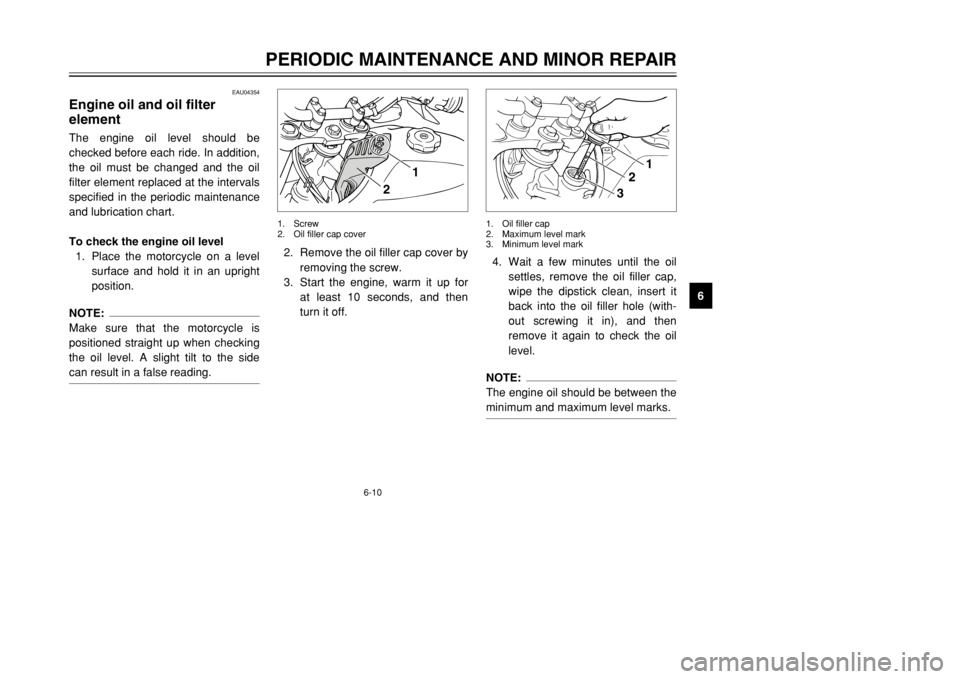light YAMAHA XT500E 2002 User Guide
[x] Cancel search | Manufacturer: YAMAHA, Model Year: 2002, Model line: XT500E, Model: YAMAHA XT500E 2002Pages: 100, PDF Size: 2.1 MB
Page 43 of 100

6-5
PERIODIC MAINTENANCE AND MINOR REPAIR
6
EAU03884
NOTE:
8The air filter needs more frequent service if you are riding in unusually wet or dusty areas.
8Hydraulic brake service
9Regularly check and, if necessary, correct the brake fluid level.
9Every two years replace the internal components of the brake master cylinders and calipers, and change the
brake fluid.
9Replace the brake hoses every four years and if cracked or damaged.20
*Rear suspension relay
arm and connecting arm
pivoting points•Check operation.√√√√
•Lubricate with molybdenum disulfide grease.√√
21*Carburetor•Check starter (choke) operation.
•Adjust engine idling speed.√√√√√ √
22 Engine oil•Change.
•Check oil level and vehicle for oil leakage.√√√√√ √
23 Engine oil filter element•Replace.√√√
24*Front and rear brake
switches•Check operation.√√√√√ √
25 Moving parts and cables•Lubricate.√√√√ √
26*Lights, signals and
switches•Check operation.
•Adjust headlight beam.√√√√√ √ NO. ITEM CHECK OR MAINTENANCE JOBODOMETER READING (× 1,000 km)
ANNUAL
CHECK
1 10203040
4PT-E7 (English) 6/29/01 9:13 AM Page 42
Page 47 of 100

6-9
PERIODIC MAINTENANCE AND MINOR REPAIR
6To check the spark plug
1. Check that the porcelain insula-
tor around the center electrode
of the spark plug is a medium-to-
light tan (the ideal color when the
motorcycle is ridden normally).
NOTE:
If the spark plug shows a distinctly
different color, the engine could be
defective. Do not attempt to diagnose
such problems yourself. Instead,
have a Yamaha dealer check the
motorcycle.2. Check the spark plug for elec-
trode erosion and excessive car-
bon or other deposits, and
replace it if necessary.3. Install the spark plug with the
spark plug wrench, and then
tighten it to the specified torque.
NOTE:
If a torque wrench is not available
when installing a spark plug, a good
estimate of the correct torque is 1/4-
1/2 turn past finger tight. However,
the spark plug should be tightened to
the specified torque as soon as pos-
sible.4. Install the spark plug cap. To install the spark plug
1. Measure the spark plug gap with
a wire thickness gauge and, if
necessary, adjust the gap to
specification.
2. Clean the surface of the spark
plug gasket and its mating sur-
face, and then wipe off any grime
from the spark plug threads.
a
a. Spark plug gap
Specified spark plug:
DPR8EA-9 or
DPR9EA-9 (NGK)
Spark plug gap:
0.8–0.9 mm
Tightening torque:
Spark plug:
17.5 Nm (1.75 m0kgf)
4PT-E7 (English) 6/29/01 9:13 AM Page 46
Page 48 of 100

6-10
PERIODIC MAINTENANCE AND MINOR REPAIR
6
EAU04354
Engine oil and oil filter
elementEngine oil and oil filter elementThe engine oil level should be
checked before each ride. In addition,
the oil must be changed and the oil
filter element replaced at the intervals
specified in the periodic maintenance
and lubrication chart.
To check the engine oil level
1. Place the motorcycle on a level
surface and hold it in an upright
position.NOTE:
Make sure that the motorcycle is
positioned straight up when checking
the oil level. A slight tilt to the side
can result in a false reading.
4. Wait a few minutes until the oil
settles, remove the oil filler cap,
wipe the dipstick clean, insert it
back into the oil filler hole (with-
out screwing it in), and then
remove it again to check the oil
level.NOTE:
The engine oil should be between the
minimum and maximum level marks.
1
2
3
1. Oil filler cap
2. Maximum level mark
3. Minimum level mark
2. Remove the oil filler cap cover by
removing the screw.
3. Start the engine, warm it up for
at least 10 seconds, and then
turn it off.
2
1
1. Screw
2. Oil filler cap cover
4PT-E7 (English) 6/29/01 9:13 AM Page 47
Page 52 of 100

6-14
PERIODIC MAINTENANCE AND MINOR REPAIR
6 3. Lightly tap the air filter element to
remove most of the dust and dirt,
and then blow the remaining dirt
out with compressed air as
shown. If the air filter element is
damaged, replace it.
4. Insert the air filter element into
the air filter case with the arrow
mark on the top pointing inward.
EAU00629
Adjusting the carburetorCarburetor, adjustingThe carburetor is an important part of
the engine and requires very sophisti-
cated adjustment. Therefore, most
carburetor adjustments should be left
to a Yamaha dealer, who has the
necessary professional knowledge
and experience. The adjustment
described in the following section,
however, may be serviced by the
owner as part of routine mainte-
nance.
EC000094
cCThe carburetor has been set and
extensively tested at the Yamaha
factory. Changing these settings
without sufficient technical knowl-
edge may result in poor perfor-
mance of or damage to the engine.
1
1. Mesh side
EC000082
cC8Make sure that the air filter ele-
ment is properly seated in the
air filter case.
8The engine should never be
operated without the air filter
element installed, otherwise
the piston and/or cylinder may
become excessively worn.5. Install the air filter case cover by
installing the screws.
6. Install the panel.
1
1. Arrow mark
4PT-E7 (English) 6/29/01 9:13 AM Page 51
Page 60 of 100

6-22
PERIODIC MAINTENANCE AND MINOR REPAIR
6
EW000109
wA soft or spongy feeling in the
brake pedal can indicate the pres-
ence of air in the hydraulic system.
If there is air in the hydraulic sys-
tem, have a Yamaha dealer bleed
the system before operating the
motorcycle. Air in the hydraulic
system will diminish the braking
performance, which may result in
loss of control and an accident.
EAU00721
Checking the front and rear
brake padsFront and rear brake pads, checkingThe front and rear brake pads must
be checked for wear at the intervals
specified in the periodic maintenance
and lubrication chart.
EAU00713
Adjusting the rear brake light
switchRear brake light switch, adjustingThe rear brake light switch, which is
activated by the brake pedal, is prop-
erly adjusted when the brake light
comes on just before braking takes
effect. If necessary, adjust the brake
light switch as follows.
Turn the adjusting nut while holding
the rear brake light switch in place.
To make the brake light come on ear-
lier, turn the adjusting nut in direction
a. To make the brake light come on
later, turn the adjusting nut in direc-
tion b.
21
a
b
1. Rear brake light switch
2. Adjusting nut
4PT-E7 (English) 6/29/01 9:13 AM Page 59
Page 71 of 100

6-33
PERIODIC MAINTENANCE AND MINOR REPAIR
6
EC000103
cCDo not use a fuse of a higher
amperage rating than recommend-
ed to avoid causing extensive
damage to the electrical system
and possibly a fire.3. Turn the key to “ON” and turn on
the electrical circuits to check if
the devices operate.
4. If the fuse immediately blows
again, have a Yamaha dealer
check the electrical system.3. Disconnect the headlight coupler
and the auxiliary light leads, and
then remove the headlight bulb
cover.
3
1
2
1. Headlight coupler
2. Auxiliary light lead (×2)
3. Headlight bulb cover
EAU01146
Replacing the headlight bulbHeadlight bulb, replacingThis motorcycle is equipped with a
quartz bulb headlight. If the headlight
bulb burns out, replace it as follows.
1. Remove cowling A. (See page
6-7 for cowling removal and
installation procedures.)
2. Remove the headlight unit by
removing the bolts.
1
1. Bolt (×3)
4PT-E7 (English) 6/29/01 9:13 AM Page 70
Page 72 of 100

6-34
PERIODIC MAINTENANCE AND MINOR REPAIR
6 4. Remove the headlight bulb hold-
er by turning it counterclockwise,
and then remove the defective
bulb.
EW000119
wHeadlight bulbs get very hot.
Therefore, keep flammable prod-
ucts away from a lit headlight bulb,
and do not touch the bulb until it
has cooled down.
1
1. Headlight bulb holder
6. Install the bulb cover, and then
connect the coupler and leads.
7. Install the headlight unit by
installing the bolts.
8. Install the cowling.
9. Have a Yamaha dealer adjust
the headlight beam if necessary.
5. Place a new bulb into position,
and then secure it with the bulb
holder.
EC000105
cCDo not touch the glass part of the
headlight bulb to keep it free from
oil, otherwise the transparency of
the glass, the luminosity of the
bulb, and the bulb life will be
adversely affected. Thoroughly
clean off any dirt and fingerprints
on the headlight bulb using a cloth
moistened with alcohol or thinner.
a
a. Do not touch this area.
4PT-E7 (English) 6/29/01 9:13 AM Page 71
Page 73 of 100

6-35
PERIODIC MAINTENANCE AND MINOR REPAIR
6
EAU03497
Replacing a turn signal light
bulbTurn signal light bulb, replacing1. Remove the turn signal light lens
by removing the screw.
1
2
1. Screw
2. Lens
EAU01623
Replacing the tail/brake light
bulbTail/brake light bulb, replacing1. Remove the tail/brake light lens
by removing the screws.
21
1. Screw (×2)
2. Lens
2. Remove the defective bulb by
pushing it in and turning it coun-
terclockwise.
3. Insert a new bulb into the socket,
push it in, and then turn it clock-
wise until it stops.
4. Install the lens by installing the
screw.
ECA00065
cCDo not overtighten the screw, oth-
erwise the lens may break.
1
1. Bulb
4PT-E7 (English) 6/29/01 9:13 AM Page 72
Page 84 of 100

7-2
MOTORCYCLE CARE AND STORAGE
7 8 8
Do not use any harsh chemical
products on plastic parts. Be
sure to avoid using cloths or
sponges which have been in
contact with strong or abra-
sive cleaning products, sol-
vent or thinner, fuel (gasoline),
rust removers or inhibitors,
brake fluid, antifreeze or elec-
trolyte.
8 8
Do not use high-pressure
washers or steam-jet cleaners
since they cause water seep-
age and deterioration in the
following areas: seals (of
wheel and swingarm bearings,
fork and brakes), electric com-
ponents (couplers, connec-
tors, instruments, switches
and lights), breather hoses
and vents.8 8
For motorcycles equipped
with a windshield: Do not use
strong cleaners or hard
sponges as they will cause
dulling or scratching. Some
cleaning compounds for plas-
tic may leave scratches on the
windshield. Test the product
on a small hidden part of the
windshield to make sure that it
does not leave any marks. If
the windshield is scratched,
use a quality plastic polishing
compound after washing.
After normal useRemove dirt with warm water, a mild
detergent, and a soft, clean sponge,
and then rinse thoroughly with clean
water. Use a toothbrush or bottle-
brush for hard-to-reach areas.
Stubborn dirt and insects will come
off more easily if the area is covered
with a wet cloth for a few minutes
before cleaning.After riding in the rain, near the sea
or on salt-sprayed roadsSince sea salt or salt sprayed on
roads during winter are extremely
corrosive in combination with water,
carry out the following steps after
each ride in the rain, near the sea or
on salt-sprayed roads.NOTE:
Salt sprayed on roads in the winter
may remain well into spring.1. Clean the motorcycle with cold
water and a mild detergent, after
the engine has cooled down.
ECA00012
cCDo not use warm water since it
increases the corrosive action of
the salt.2. Apply a corrosion protection
spray on all metal, including
chrome- and nickel-plated, sur-
faces to prevent corrosion.
4PT-E7 (English) 6/29/01 9:13 AM Page 83
Page 92 of 100

8-4
SPECIFICATIONS
8
Electrical
Ignition system T.C.I. (Digital)
Charging system
Type A.C. magneto
Standard output 14 V, 13.5A @ 5,000 rpm
Battery
Type YTX9-BS
Voltage, capacity 12 V, 8 AH
Headlight bulb typeHalogen bulb
Bulb voltage, wattage ×quantity
Headlight 12 V, 60/55W ×1
Tail/brake light 12 V, 5/21W ×1
Auxiliary light 12 V, 4W ×1
12 V, 3.4W ×1 (GB only)
Front flasher light 12 V, 21W ×2
Rear flasher light 12 V, 21W ×2
Meter lighting 12 V, 3.4W ×1
Neutral indicator light 12 V, 3.4W ×1
High beam indicator light 12 V, 3.4W ×1
Turn indicator light 12 V, 3.4W ×1
Fuse20A
4PT-E7 (English) 6/29/01 9:13 AM Page 91